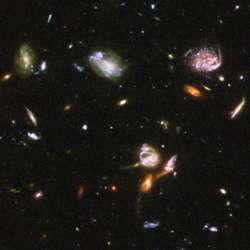GREAT3 challenge seeks new methods for measuring weak gravitational lensing

(Phys.org) —Think you can figure out a way to unlock one of the biggest secrets of the universe? The recently launched third Gravitational Lensing Accuracy Testing challenge (GREAT3) is giving researchers the opportunity to do just that.
GREAT3, which is led by Carnegie Mellon University's Rachel Mandelbaum and UCL's (University College London's) Barnaby Rowe, invites researchers from many fields, including astrophysics, statistics and machine learning, to test new and existing methods for measuring weak gravitational lensing. Weak gravitational lensing is one of the most direct - but also most difficult - ways scientists have to learn about the mysterious invisible dark matter and dark energy that dominates our universe.
"In previous challenges, people have come up with entirely new methods for measuring weak gravitational lensing that we are using in practice today. We're excited to think about what people will come up with in this challenge, and to think about what new information we'll learn about existing methods for measuring weak lensing," said Mandelbaum, who is an assistant professor of physics and member of the McWilliams Center for Cosmology at Carnegie Mellon.
When light from distant galaxies travels through the universe, its path is deflected as it passes by other galaxies or large clumps of matter, including dark matter. This effect, called weak gravitational lensing, results in small distortions in how distant galaxies are viewed from earth and space-based telescopes. Scientists can use lensing measurements to map dark matter and study how it has changed over time. As a result, they can better understand dark energy.
Measuring weak lensing, however, is extremely difficult. The distortions are so tiny that researchers must collect and sift through data from millions of galaxies. They must also be able to correct for things like blurring caused by telescopes or the atmosphere.
"Analyzing weak lensing is tricky, there are a number of things in the atmosphere and in our instruments that can meddle with our data," said Rowe, a postdoctoral research associate at UCL. "GREAT3 is a fair test to see how new and current methods handle these types of problems and provide accurate results."
In the challenge, participants download simulated data created by GalSim, an open-source image simulation software package developed by a team including Mandelbaum and Rowe for GREAT3. The images, which are similar in format to what is gathered by today's high-powered telescopes, contain galaxies that have some weak lensing distortion that is known only to the developers of the challenge. The participants are given a series of experiments, each of which test for a different problem or set of problems specific to weak lensing measurements. The participants then use their own algorithm for measuring weak lensing to figure out what weak lensing distortion was used in the simulation. They send their results to the organizers, and the team that comes the closest to measuring the correct weak lensing distortion wins.
The competition is not just open to scientists studying weak lensing. In fact, the organizers hope that researchers from other areas of science, like machine learning and statistics, will join the challenge. "Computer scientists and particle physicists excelled in previous challenges," Rowe said. "And this brings new skills and ideas to the problem."
"For those outside of the astrophysics community, there can be a great barrier to studying weak lensing," Mandelbaum said. "But fields like machine learning could prove to be invaluable for helping us pull information out of our huge data sets, which can contain tens of millions of galaxies. The controlled nature of the simulations, along with the simple and well-described data formats used for the challenge, lowers the barrier to entry for people outside of astronomy."
Information about GREAT3 is available at the challenge website, and data for GREAT3 is available from great3.projects.phys.ucl.ac.uk/leaderboard/ . Participants have until April 30, 2014 to complete the challenge, and the winner will receive a prize such as a laptop, in addition to worldwide recognition of their efforts.
GREAT3 is funded by NASA through the Strategic University Research Partnership Program of the Jet Propulsion Laboratory, California Institute of Technology and the IST Programme of the European Community under the PASCAL2 Network of Excellence.
Provided by Carnegie Mellon University


















